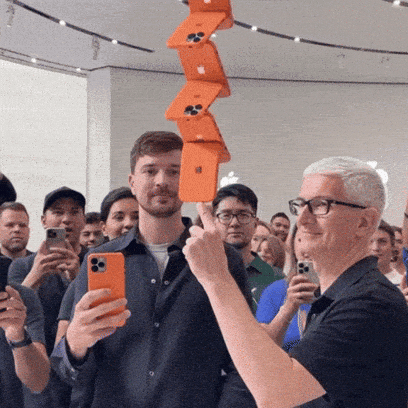- Benzinga Tech Trends
- Posts
- iPhone Air Redefines Thin — Or Does It?
iPhone Air Redefines Thin — Or Does It?

Apple is at it again — slimming down the iPhone in ways no one really asked for, but everyone’s now curious about. Meet the iPhone Air, Apple’s newest gadget that’s making waves not just for what it adds, but also for what it leaves out.
Meet The iPhone Air
At just 5.6 millimeters, this is the thinnest iPhone Apple has ever built.
Think “MacBook Air, but pocket-sized.”
It weighs only 165 grams, has a titanium frame, and comes in sleek finishes like Sky Blue and Cloud White. Apple packed in its powerful A19 Pro chip, a dazzling 6.5-inch OLED screen with 120Hz refresh rate, and upgraded front-facing camera tricks like Dual Capture — so you can film yourself and what you’re looking at, simultaneously.
But here’s the twist: to keep things ultra-thin, Apple cut down the rear camera system to just one 48MP main lens. No ultra-wide, no telephoto. For casual shooters, it’s fine — but if you love zooming in on your dog from across the park, you’ll miss the extra lenses found on the Pro models.

Source: Giphy
Thinness Vs. The Competition
So how does the Air stack up? Compared to the iPhone 17 Pro, it feels more like a fashion statement — thinner, lighter and less versatile for photography.
Against Samsung’s Galaxy S25 Edge, Apple wins the slimness game hands down, but loses ground on battery size and camera versatility. Android rivals still push bigger batteries and faster charging, while Apple bets you’ll prioritize style and ecosystem perks.
What Apple Wants You To Understand
Apple’s pitch is clear: the iPhone Air is for those who want cutting-edge design and don’t mind a few trade-offs. It may not be the camera powerhouse or battery beast, but it’s the phone you’ll flex at the coffee shop.
The big question is whether this ultra-slim gamble drives upgrades — or whether customers will play it safe with the Pro lineup.
This Week In Tech
Honeywell And Redwire's Quantum Satellite
Honeywell Inc. and Redwire Corporation have signed a Memorandum of Understanding to assist the European Space Agency in developing a satellite for quantum-secured communications. This partnership is part of the Quantum Key Distribution Satellite program, initiated in 2024 under Honeywell's leadership.
Oracle's Massive Cloud Contracts
Oracle Corp. continued its upward trajectory, building on last week’s historic rally influenced by OpenAI’s impact across technology markets. The software giant recorded its largest stock jump since 1992, driven by a surge in cloud commitments.
Intel's Altera Stake Sale
Intel Corp. shares rose after the company announced the completion of a deal to sell a majority stake in its Altera business to Silver Lake. The transaction, which was signed on April 14, 2025, closed on Sept. 12 after meeting all conditions. Silver Lake acquired 51% of Altera for about $3.3 billion, while Intel retained a 49% interest.
Apple's iPhone 17 Demand
An analyst tracking Apple Inc. iPhone 17 lead times shows the new smartphone is outperforming its predecessor. JPMorgan analyst Samik Chatterjee maintained an Overweight rating on Apple with a $255 price target.
Nokia's 5G Rail Network
Nokia has partnered with Deutsche Bahn, Germany’s national railway operator, to deploy a commercial 1900 MHz 5G radio network solution with a 5G Standalone core on live outdoor test tracks. The collaboration aims to streamline DB’s communications infrastructure, leveraging a frequency band catering to 5G railway systems in Europe.
That's all for this week! If you found these updates useful, you'll like more from this newsletter. Get deeper dives, hot takes, and all the latest tech news delivered straight to your inbox.